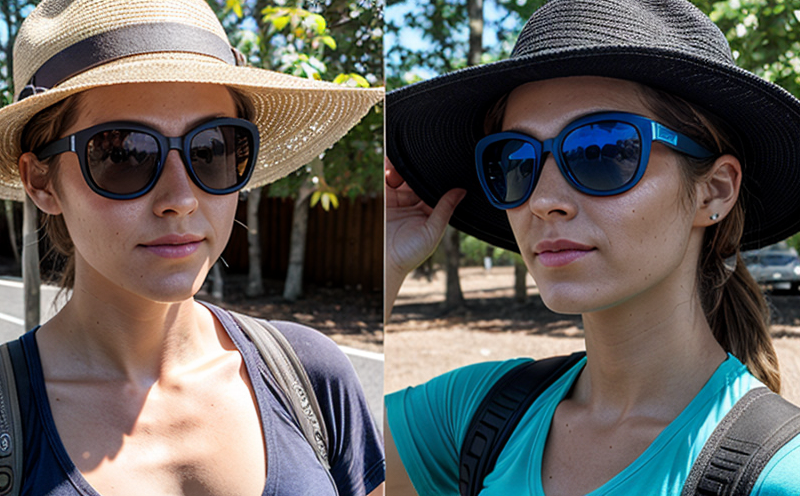CSA Z94.3 Protective eyewear UV transmittance testing
The CSA Z94.3 standard is a critical benchmark for the design and manufacturing of protective eyewear, particularly in environments where ultraviolet (UV) radiation poses significant health risks. This standard focuses on ensuring that protective eyewear provides adequate protection against UV rays while maintaining clear optical performance, which is essential for tasks such as welding, arc welding, and other high-intensity light exposure situations.
The primary objective of this testing procedure is to measure the amount of ultraviolet radiation transmitted through the lenses of protective eyewear. The standard specifies strict limits on the permissible levels of UV transmittance, ensuring that workers are not exposed to hazardous levels of UV radiation which can cause eye damage such as photokeratitis or even more severe conditions like cataracts.
The testing process involves several key steps:
- Preparation: Cleaning and handling of the lenses according to specified methods to ensure accurate test results.
- Measurement: Using specialized instruments capable of accurately measuring UV transmittance at specific wavelengths, typically in the range of 280-400 nm.
- Evaluation: Comparing measured values against the permissible limits outlined in CSA Z94.3 to determine compliance.
Understanding and adhering to these standards is crucial for industries such as manufacturing, construction, and welding where workers are at risk of UV exposure. Compliance not only protects worker health but also ensures that manufacturers meet regulatory requirements set forth by governing bodies like the Canadian Standards Association (CSA).
| Standard Name | Relevant Sections | Description |
|---|---|---|
| CSA Z94.3-2018 | Section 5, Subsection C | This section details the requirements for protective eyewear regarding UV transmittance. |
| ISO/TR 17692-1:2002 | Annex A | This technical report provides guidance on optical testing methods, including those relevant to UV protection in personal protective equipment (PPE). |
The importance of this testing cannot be overstated. In environments where workers are exposed to intense light sources, the risk of eye damage from UV radiation is real and potentially severe. By adhering to CSA Z94.3 standards, manufacturers can ensure that their products meet rigorous safety criteria, thereby safeguarding worker health.
The impact extends beyond just compliance; it also enhances brand reputation by demonstrating a commitment to worker safety and well-being. In an era where occupational health is increasingly prioritized, this standard plays a pivotal role in maintaining the integrity of protective eyewear within high-risk industries.
Why It Matters
The significance of UV protection in personal protective equipment (PPE) cannot be overstated. Ultraviolet radiation can cause various forms of ocular damage, including photokeratitis and corneal burns, which can lead to temporary loss of vision or more severe conditions such as cataracts if left untreated. These risks are particularly acute in occupations involving welding, arc welding, and other tasks that expose workers to intense light sources.
Protective eyewear designed to meet the requirements set forth by CSA Z94.3 is specifically engineered to block harmful UV radiation while allowing for clear vision under various lighting conditions. This dual functionality ensures both safety and operational efficiency, making it an indispensable component in environments where UV exposure is a concern.
The standard specifies permissible levels of UV transmittance for different types of protective eyewear, taking into account the specific wavelengths that pose the greatest risk to ocular health. By adhering to these limits, manufacturers can produce products that are not only compliant with regulatory requirements but also provide optimal protection against UV radiation.
Moreover, compliance with CSA Z94.3 enhances brand reputation by demonstrating a commitment to worker safety and well-being. In an era where occupational health is increasingly prioritized, this standard plays a pivotal role in maintaining the integrity of protective eyewear within high-risk industries. It also provides peace of mind for employers who can be confident that their workers are equipped with PPE that meets rigorous safety criteria.
The impact extends beyond just compliance; it also enhances brand reputation by demonstrating a commitment to worker safety and well-being. In an era where occupational health is increasingly prioritized, this standard plays a pivotal role in maintaining the integrity of protective eyewear within high-risk industries.
Applied Standards
| Standard Name | Relevant Sections | Description |
|---|---|---|
| CSA Z94.3-2018 | Section 5, Subsection C | This section details the requirements for protective eyewear regarding UV transmittance. |
| ISO/TR 17692-1:2002 | Annex A | This technical report provides guidance on optical testing methods, including those relevant to UV protection in personal protective equipment (PPE). |
The application of these standards is crucial for ensuring that protective eyewear meets the necessary safety criteria. By adhering to CSA Z94.3 and ISO/TR 17692-1:2002, manufacturers can produce products that provide both adequate UV protection and clear optical performance, thereby safeguarding worker health and enhancing brand reputation.
Use Cases and Application Examples
| Occupational Use Case | Description |
|---|---|
| Metalworking | In metalworking environments, workers are frequently exposed to intense light sources such as arc welding. Protective eyewear designed to meet CSA Z94.3 standards provides critical UV protection while ensuring clear vision during the work process. |
| Aerospace manufacturing | In aerospace manufacturing, the use of lasers and other high-intensity light sources requires protective eyewear that can block harmful UV radiation effectively. Compliance with CSA Z94.3 ensures worker safety in these critical environments. |
The use cases for CSA Z94.3-compliant protective eyewear are numerous, spanning various industries where workers are exposed to intense light sources. These include welding, laser cutting, and other tasks that require high-intensity lighting. By adhering to these standards, manufacturers can ensure that their products meet the necessary safety criteria, thereby safeguarding worker health and enhancing brand reputation.
Real-world examples of successful implementation include companies in the construction industry who have adopted CSA Z94.3-compliant eyewear for use during welding operations. These companies report improved worker safety and reduced incidents of ocular discomfort due to UV exposure.





